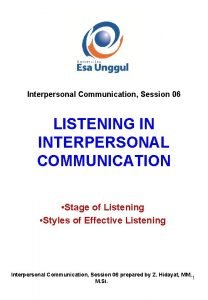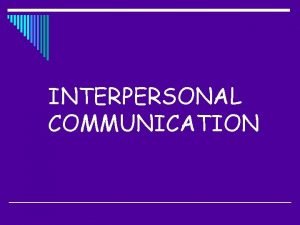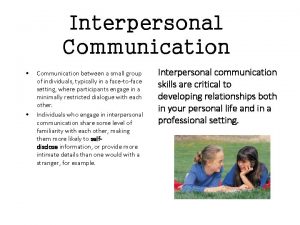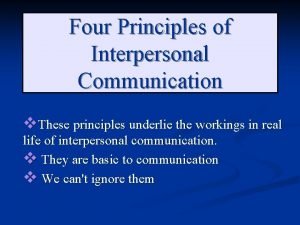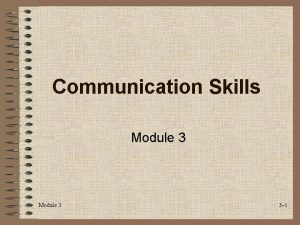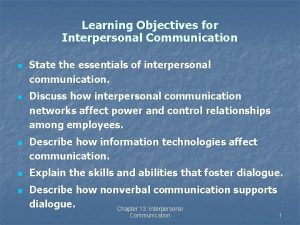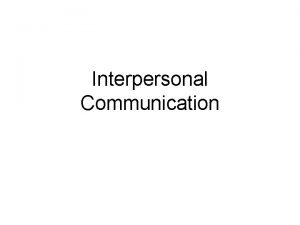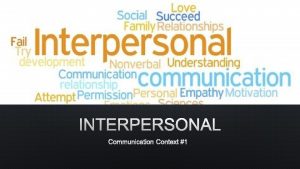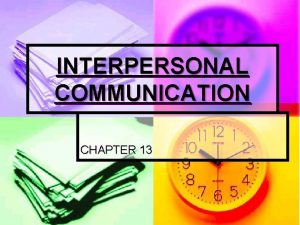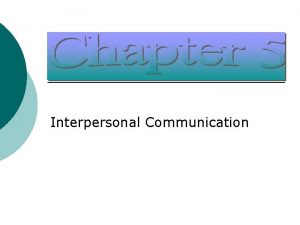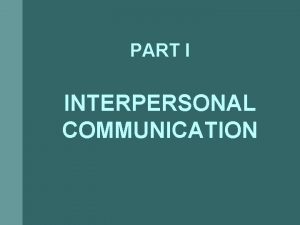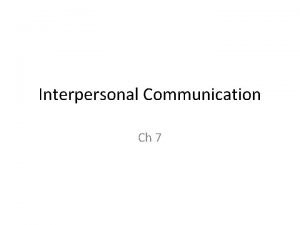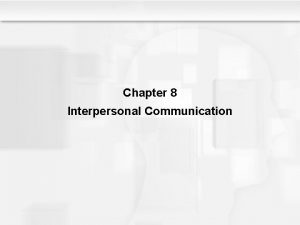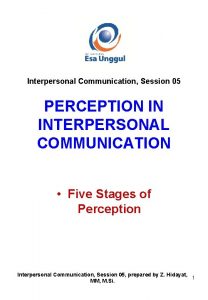Effective Communication 1 Interpersonal Communication The exchange of
























- Slides: 24

Effective Communication 1

Interpersonal Communication The exchange of a message across a communication channel from one person to another Three problem areas Intended message versus message sent Message sent versus message received Message received versus message interpreted 2

Sender Receiver Encodes Message Sends Message Receives Message Decodes Message What I want to say What I say I hear her say I think she means 3

Problem Area I: Intended Message Versus Message Sent Think about what you want to communicate Practice what you want to communicate Learn better communication skills 4

Problem Area II: Message Sent Versus Message Received Actual words used Communication channel Noise Nonverbal cues Paralanguage Artifacts Amount of information 5

Actual Words Used The word “fine” to describe jewelry to describe the weather to describe food or sex The applicant female girl babe woman was a: 6

Use concrete words and ask how the other person might interpret your message Avoid such words as: as soon as possible I’ll be back soon I’ll be out for a while Why not be specific? Avoid confrontation “test the water” Avoid being the bad guy (MUM effect) 7

Gender Differences in Communication (Tannen, 1986 & 1990) Men Talk about major events Tell the main point Are more direct Use “uh-huh” to agree Are comfortable with silence Concentrate on the words spoken Sidetrack unpleasant topics Women Talk about daily life Provide details Are more indirect Use “uh-huh” to listen Are less comfortable with silence Concentrate on nonverbal cues and paralanguage Focus on unpleasant topics 8

Men are from Mars, Women are from Venus 9

Communication Channels Oral in-person word-of-mouth answering machine Nonverbal Written personal general letter/memo email 10

Noise Actual noise Appropriateness of the channel Bias Feelings about the person communicating Mood Perceived motives 11

Nonverbal Cues Are ambiguous Those that aren’t, are called emblems Gender and cultural differences are common Nonverbal cues are thought to be 80% of the message received 12

Nonverbal Cues Include Eye contact Expressions Micro-expressions Posture Arm and leg use Motion Touching 13 http: //www. youtube. com/watch? v=AQENw. D-Ql. RA&feature=related

Use of Space Intimacy zone 0 to 18 inches close relationships Personal distance zone 18 inches to 4 feet friends and acquaintances Social distance zone 4 to 12 feet business contacts and strangers Public distance zone 12 to 25 feet 14 http: //www. youtube. com/watch? v=_s 39 Br. B 9 o. LQ

Use of Time Being late Leaving a meeting early Setting aside time for a meeting Multi-tasking (working while talking) 15

Basic Assumptions About Nonverbal Cues & Paralanguage People are different in their use of nonverbal cues and paralanguage Standard differences among people reveal information about the person Changes in a person’s style reveal new messages 16

Paralanguage Rate of speech Loudness Intonation Amount Voice of talking pitch Pauses http: //www. youtube. com/watch? v=pjmkb 5 HCGLA 17

The Importance of Inflection I did not say Bill stole your car. I did not say Bill store your car. I did not say Bill stole your car. 18

The Importance of Listening 70% of a manager’s job is spent communicating Of that time 9% is spent writing 16% is spent reading 30% is spent speaking 45% is spent listening 19

Listening Skills Stop talking and listen Show the speaker you want to listen Empathize with the speaker Don’t ask excessive questions Remove distractions Keep an open mind Use appropriate nonverbal cues Let the other person finish speaking Try to understand what the other person means 20

Listening Styles (Geier & Downey, 1980) Leisure Inclusive Stylistic Technical Empathic Nonconforming 21

Other Factors Emotional State Anger Fear Anxiety Excitement Love Bias Cognitive Ability Drugs and Alcohol 22

Writing is easiest to read when it: has short sentences uses simple rather than complicated words uses common rather than unusual words 23

Comparison of Readability Scales Readability Index Method Fry Flesch Average number of syllables per word X X Average sentence length X X FOG Average number of words per sentence X Average number of 3 syllable words X Number of unusual words Dale-Chall X 24
 Interpersonal communication vocabulary
Interpersonal communication vocabulary Types of nonverbal communication chronemics
Types of nonverbal communication chronemics Foreign exchange means
Foreign exchange means Addison currency exchange
Addison currency exchange Voluntary exchange
Voluntary exchange Gas exchange key events in gas exchange
Gas exchange key events in gas exchange Interpersonal skills vs intrapersonal skills
Interpersonal skills vs intrapersonal skills Mastering team skills and interpersonal communication
Mastering team skills and interpersonal communication Basic interpersonal communication skills
Basic interpersonal communication skills Pengertian interpersonal skill
Pengertian interpersonal skill Listening styles interpersonal communication
Listening styles interpersonal communication Politeness theory in communication
Politeness theory in communication What is communication is contextual
What is communication is contextual Gender and interpersonal communication
Gender and interpersonal communication Interpersonal situations
Interpersonal situations 6 interpersonal skills
6 interpersonal skills Inescapable communication
Inescapable communication Module 3 communication/interpersonal skills
Module 3 communication/interpersonal skills Impersonal communication
Impersonal communication Which factor characterizes masspersonal communication
Which factor characterizes masspersonal communication Interpersonal communication and emotional intelligence
Interpersonal communication and emotional intelligence Element of interpersonal communication
Element of interpersonal communication Skills job application
Skills job application In interpersonal communication ethics
In interpersonal communication ethics Interpersonal communication barriers
Interpersonal communication barriers










